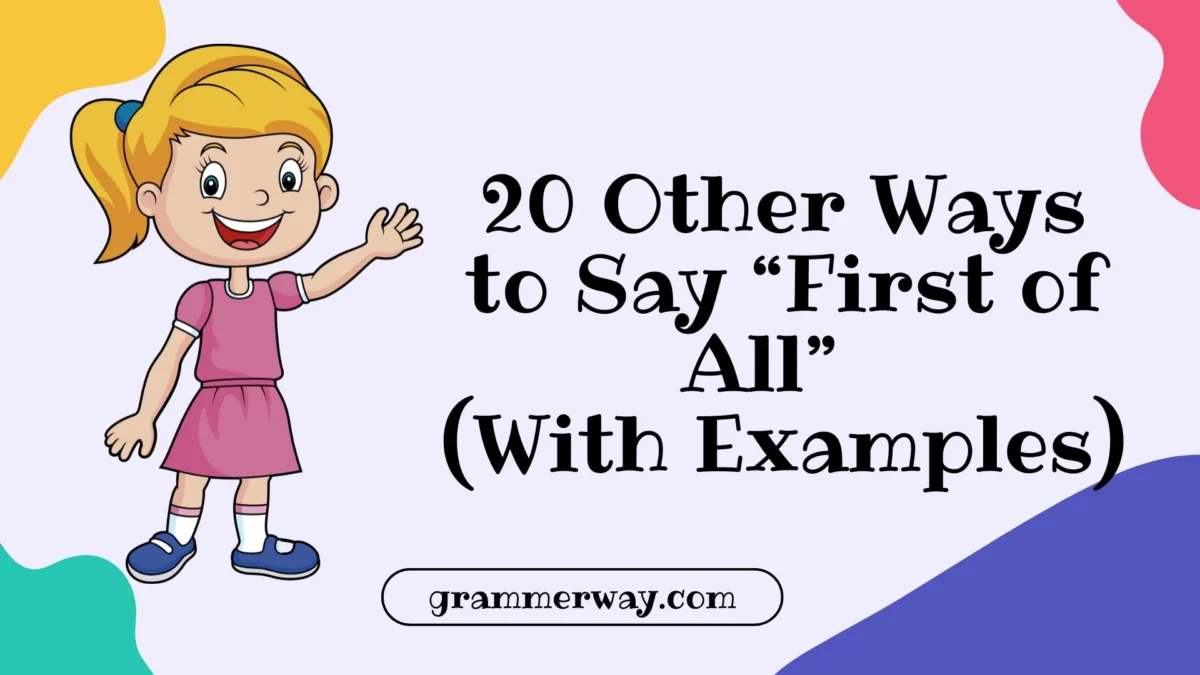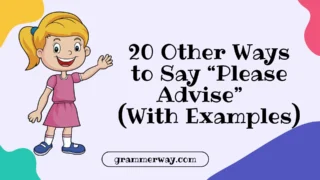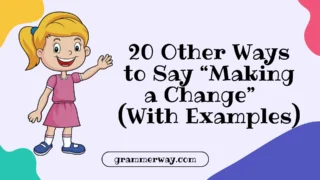When starting a conversation, message, or explanation, the phrase “First of all” often feels like the natural choice. It helps us introduce our thoughts clearly and set the stage for what comes next. But sometimes, using different ways to say “first of all” can make your tone warmer, more thoughtful, and more engaging. Choosing the right words can show care, empathy, and professionalism while making your message feel more genuine and meaningful.
Below, you’ll discover 20 alternative phrases for “first of all”—each with meanings, tones, and examples to help you express yourself with clarity and kindness.
What Does “First of All” Mean?
The phrase “first of all” is used to introduce the first point, reason, or step in a series of ideas or explanations. It helps structure your thoughts and signals to the listener or reader that something important is about to be shared. It often implies that more points will follow, creating a natural flow of communication.
In simple words, it means “to begin with” or “as the first point to consider.” It’s a transitional phrase that organizes your ideas while helping others follow along with your reasoning.
Is It Professional or Polite to Say “First of All”?
Yes, saying “first of all” is both professional and polite in most contexts. It’s widely accepted in conversations, presentations, and writing. However, in certain formal or creative situations, repeating it too often may sound repetitive or overly structured. That’s why exploring other ways to say “first of all” can help you sound smoother, warmer, and more natural.
Synonyms for “First of All”
- To begin with
- Firstly
- Before anything else
- To start with
- At the outset
- To kick things off
- Primarily
- To open with
- As a starting point
- Initially
- In the beginning
- From the start
- As the first step
- To commence with
- Before we proceed
- As an introduction
- To lay the foundation
- As a foremost point
- To break the ice
- To set the stage
1. To Begin With
Meaning: This phrase gently introduces the first idea or point in a discussion. Tone: Polite, neutral, and easy-going.
Explanation: “To begin with” feels welcoming and professional. It’s perfect for both formal and casual settings, showing that you’re about to explain something thoughtfully.
Scenario: You’re starting a presentation or a conversation. Examples:
- To begin with, I want to thank everyone for their time today.
- To begin with, we need to understand the customer’s main concern.
- To begin with, let’s focus on building trust with the client.
- To begin with, I’d like to share some positive news.
- To begin with, it’s important to clarify our main goal.
2. Firstly
Meaning: Used to introduce the first point in a structured list or argument. Tone: Formal and organized.
Explanation: “Firstly” sounds professional and works well in essays, reports, and speeches. It gives your thoughts a clear sequence.
Scenario: Business reports, presentations, or academic writing. Examples:
- Firstly, we need to review last quarter’s performance.
- Firstly, I’d like to address the main concern you mentioned.
- Firstly, communication should be our top priority.
- Firstly, we must acknowledge the challenges we faced.
- Firstly, our focus should be on improving customer satisfaction.
3. Before Anything Else
Meaning: Expresses importance and prioritization. Tone: Warm, direct, and thoughtful.
Explanation: This phrase shows genuine care by highlighting that something matters most before moving forward.
Scenario: Conversations with coworkers or friends. Examples:
- Before anything else, I want to say thank you for your help.
- Before anything else, let’s make sure everyone feels comfortable.
- Before anything else, we should confirm the plan together.
- Before anything else, take a deep breath and relax.
- Before anything else, I want to appreciate your hard work.
4. To Start With
Meaning: Introduces the first topic or idea in a friendly way. Tone: Conversational and light.
Explanation: “To start with” feels more casual than “firstly” and adds a softer beginning to your speech.
Scenario: Everyday conversations or informal writing. Examples:
- To start with, let’s talk about what went well.
- To start with, we need to organize the files properly.
- To start with, I want to thank you for joining the meeting.
- To start with, we should look at the bigger picture.
- To start with, communication is key to success.
5. At the Outset
Meaning: Means “at the very beginning” of something. Tone: Formal and sophisticated.
Explanation: Great for formal letters, speeches, and professional writing. It adds a polished tone.
Scenario: Introductions in professional contexts. Examples:
- At the outset, I want to express my gratitude to the team.
- At the outset, we must clarify our shared objectives.
- At the outset, it’s important to set clear expectations.
- At the outset, I’d like to thank our partners.
- At the outset, we need to define our priorities.
6. To Kick Things Off
Meaning: Used to start something in a fun, energetic way. Tone: Friendly and casual.
Explanation: Perfect for lighthearted meetings or events, it adds enthusiasm to your speech.
Scenario: Informal team meetings or events. Examples:
- To kick things off, let’s start with a quick update.
- To kick things off, I’d like to share some exciting news.
- To kick things off, we’ll play a short game.
- To kick things off, let’s welcome our new team member.
- To kick things off, I’ll begin with the main highlights.
7. Primarily
Meaning: Indicates the main or most important point. Tone: Clear, formal, and professional.
Explanation: “Primarily” shows focus and purpose, especially in business or technical discussions.
Scenario: Explaining data or strategic points. Examples:
- Primarily, our goal is to improve customer satisfaction.
- Primarily, we want to reduce unnecessary costs.
- Primarily, this report focuses on long-term goals.
- Primarily, we aim to strengthen internal communication.
- Primarily, we need to review our workflow efficiency.
8. To Open With
Meaning: Used when introducing the first topic in an event or discussion. Tone: Warm and organized.
Explanation: “To open with” gives a polite, ceremonial tone and fits both formal and semi-formal occasions.
Scenario: Events, meetings, or speeches. Examples:
- To open with, I’d like to thank our guests for attending.
- To open with, let’s reflect on our progress.
- To open with, we’ll start by revisiting last week’s feedback.
- To open with, let’s celebrate our small wins.
- To open with, I want to share an inspiring story.
9. As a Starting Point
Meaning: Suggests the first idea in a process or discussion. Tone: Neutral and constructive.
Explanation: Works great in planning, strategy, or brainstorming contexts.
Scenario: Problem-solving or planning sessions. Examples:
- As a starting point, we should review the feedback.
- As a starting point, let’s clarify our objectives.
- As a starting point, we can test a few options.
- As a starting point, I recommend identifying the key issue.
- As a starting point, it’s crucial to gather more information.
10. Initially
Meaning: Refers to something that happens first in time. Tone: Professional and direct.
Explanation: “Initially” gives a chronological sense and is best for factual or analytical writing.
Scenario: Explaining processes or project timelines. Examples:
- Initially, we focused on internal improvements.
- Initially, the results seemed unclear.
- Initially, we planned a smaller project.
- Initially, our strategy was different.
- Initially, we faced several challenges.
11. In the Beginning
Meaning: Marks the very start of an event or process. Tone: Gentle and reflective.
Explanation: A classic, timeless phrase that fits storytelling or emotional conversations.
Scenario: Sharing personal or narrative experiences. Examples:
- In the beginning, everything felt uncertain.
- In the beginning, we didn’t know what to expect.
- In the beginning, our focus was purely on growth.
- In the beginning, communication was a challenge.
- In the beginning, we learned through trial and error.
12. From the Start
Meaning: Refers to the earliest stage of something. Tone: Confident and conversational.
Explanation: Simple and natural for everyday speech, showing consistency from the start.
Scenario: Personal or business discussions. Examples:
- From the start, we believed in our vision.
- From the start, trust has been our foundation.
- From the start, we aimed for quality over quantity.
- From the start, communication was key.
- From the start, the team showed strong dedication.
13. As the First Step
Meaning: Refers to the initial action in a process. Tone: Practical and instructive.
Explanation: Great for instructions or plans where steps are involved.
Scenario: Guides or explanations. Examples:
- As the first step, review the instructions carefully.
- As the first step, identify the root cause of the issue.
- As the first step, collect all necessary materials.
- As the first step, communicate your goals clearly.
- As the first step, ensure everyone understands the plan.
14. To Commence With
Meaning: Means “to begin with” in a very formal way. Tone: Elegant and professional.
Explanation: Often used in official speeches or documents.
Scenario: Ceremonial or official communication. Examples:
- To commence with, I’d like to thank the organizers.
- To commence with, let’s review the agenda.
- To commence with, we’ll address last week’s report.
- To commence with, please share your insights.
- To commence with, we should align on our goals.
15. Before We Proceed
Meaning: Suggests addressing something important before continuing. Tone: Caring and attentive.
Explanation: It conveys mindfulness and ensures clarity before moving forward.
Scenario: Conversations requiring confirmation or understanding. Examples:
- Before we proceed, does anyone have any questions?
- Before we proceed, let’s double-check the figures.
- Before we proceed, I want to clarify one point.
- Before we proceed, let’s make sure everyone agrees.
- Before we proceed, I’d like to express my appreciation.
16. As an Introduction
Meaning: Introduces the first part of an explanation or speech. Tone: Academic and clear.
Explanation: Common in essays, research papers, and presentations.
Scenario: Writing or formal talks. Examples:
- As an introduction, I’ll outline our main objectives.
- As an introduction, it’s important to understand the background.
- As an introduction, let me provide a brief overview.
- As an introduction, here’s what we discovered.
- As an introduction, we’ll focus on the key findings.
17. To Lay the Foundation
Meaning: Refers to the first step that builds understanding. Tone: Thoughtful and constructive.
Explanation: Useful when setting context or preparing the audience.
Scenario: Teaching or explaining new ideas. Examples:
- To lay the foundation, let’s discuss the basics.
- To lay the foundation, I’ll explain our motivation.
- To lay the foundation, we must define key terms.
- To lay the foundation, let’s go over our strategy.
- To lay the foundation, we’ll start with a short example.
18. As a Foremost Point
Meaning: Highlights the most important initial point. Tone: Formal and serious.
Explanation: Ideal for strong, assertive communication.
Scenario: Business or legal discussions. Examples:
- As a foremost point, we must ensure accuracy.
- As a foremost point, teamwork remains essential.
- As a foremost point, we need full transparency.
- As a foremost point, quality should not be compromised.
- As a foremost point, our customers come first.
19. To Break the Ice
Meaning: To start something with a friendly gesture. Tone: Warm and casual.
Explanation: Perfect for relaxed conversations or events to make people comfortable.
Scenario: Team meetings or introductions. Examples:
- To break the ice, let’s start with a fun question.
- To break the ice, share your favorite hobby.
- To break the ice, let’s do a quick round of introductions.
- To break the ice, I’ll tell you a short story.
- To break the ice, let’s begin with a smile.
20. To Set the Stage
Meaning: To prepare for what’s coming next. Tone: Engaging and thoughtful.
Explanation: Creates anticipation and helps transition into the main topic smoothly.
Scenario: Presentations, speeches, or creative writing. Examples:
- To set the stage, let’s review the key background details.
- To set the stage, I’ll highlight our main challenges.
- To set the stage, we’ll discuss the upcoming goals.
- To set the stage, I want to acknowledge our progress.
- To set the stage, let’s talk about where we started.
Conclusion
Choosing other ways to say “first of all” helps you sound more natural, warm, and professional depending on the situation. Whether you’re starting a heartfelt conversation, writing an email, or presenting an idea, these phrases let you connect with your audience more meaningfully.
The key is to match your words with your tone and intention—because the right start can set the right mood for everything that follows.
FAQs
1. What’s the most formal alternative to “first of all”?
The most formal alternatives are “At the outset” and “To commence with.”
2. Can I use “to start with” in business writing?
Yes, but only in semi-formal contexts where a conversational tone is acceptable.
3. Which alternative sounds most friendly?
“Before anything else” and “To kick things off” sound friendliest and most engaging.
4. What’s a good way to begin an email without “first of all”?
Try using “To begin with” or “Before we proceed” for a polite tone.
5. Is it okay to use “firstly” and “secondly” together?
Yes, it’s perfectly fine for structured writing, especially in reports or essays.







Leave a Comment